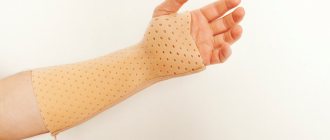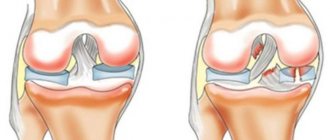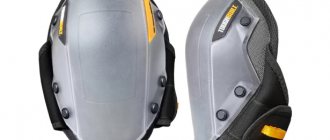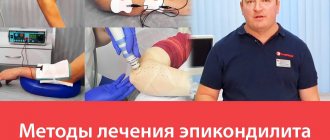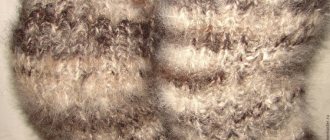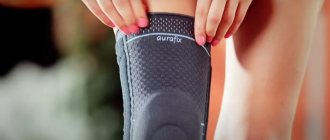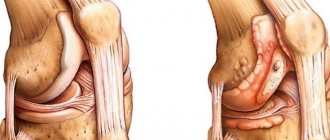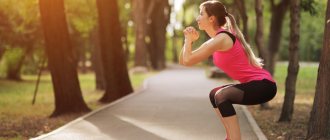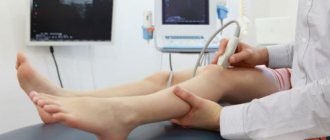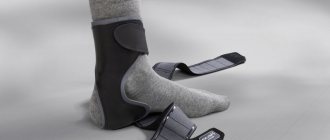One of the recommendations in the treatment of arthrosis and osteoarthritis of the knee joint is to immobilize the knee. For this purpose, special braces called knee pads have been created. They are more convenient to use than a regular elastic bandage. The main thing is to choose the right knee brace.
Knee braces seriously relieve arthrosis pain
Who needs knee pads and why?
A knee brace is designed to limit the mobility of the joint and ligaments around it, which is especially important for arthrosis, arthritis, and other diseases of the knee. They should also be used by healthy people who regularly expose this part of the body to extreme stress, for example due to profession or other circumstances.
Knee pads allow you to:
- reduce inflammation, if any;
- relieve swelling due to intensive outflow of synovial fluid;
- reduce pain;
- limit limb mobility;
- normalize blood circulation.
Types of knee orthoses
Supporting products for knee joints are distinguished by different types of designs and materials:
- Bandages (or knee pads) are made of soft, elastic fabrics that primarily compress the soft tissue and support the knee. Such models are often equipped with additional silicone rings, which additionally tighten soft tissues and secure the bandage. They are recommended when playing sports. Their main goal is to protect a healthy joint from sprains or unnecessary overload. They can also be used for sprains.
- Semi-rigid knee orthoses that support the joint and help reduce stress on it. Such models made of dense fabrics are recommended for athletes who work with heavy weights. Options made from less dense fabrics are suitable for arthritis or arthrosis and help reduce stress on the joint.
- Adjustable rigid orthoses that are suitable for knee injuries for rehabilitation.
- Orthoses that fix the knee in one plane. They are typically used to speed up the recovery of knee dislocations.
- A splint is an orthosis that has a rigid fixation with the help of additional plastic reinforcements. As a rule, it is used to restore joints after fractures or operations. The main function of the product is to fix the joint in a static position and allow the cartilage tissue to recover.
Lower limb orthoses
They also differ in design:
- Closed bandages that completely surround the joint on all sides. Such models made of elastic fabric are used in sports to protect healthy knees from injury.
- Models with stiffening ribs are used for the most strict fixation of knees after injuries. They help either fix the bend completely or limit movements in a certain direction, for example, lateral.
- Options with hinges relieve the bend and facilitate movement in case of injury or illness. The hinge takes over the partial function of flexion and extension. At the same time, the knee remains mobile.
What are they made from?
Knee braces are made from synthetic and natural materials. The first ones most often used are polyester, elastane and warming neoprene - wear-resistant, environmentally friendly and healthy materials that do not lose their properties even after prolonged wear.
Natural materials are more pleasant to the body - sheep, camel, dog hair, cotton knitwear. However, they can cause allergies and also wear out much faster than synthetic ones.
Anatomical shape and flat internal seams are the main characteristics of high-quality knee pads
Comparison table of characteristics
In order to compare the presented products, we recommend taking a look at their characteristics in the table below.
| Model | Material | Compression | Warming | Floor | Fixation elements | Price, rub.) |
| Fosta F 1259 | neoprene | Yes | Yes | unisex | fixing ring | from 450 to 1230 |
| Ottobock | silicone | Yes | No | unisex | stiffening ribs, silicone inserts | from 3850 to 4990 |
| Orlett Energy Line DKN-103 NRG | textiles, metal | Yes | No | unisex | silicone inserts, stiffeners | from 3070 to 4950 |
| Trives T-8508 | neoprene, textile, metal | No | Yes | unisex | Velcro fasteners, straps/ribbons | from 1210 to 1755 |
| Orto NKN 209 | neoprene, textile | No | Yes | unisex | fixing ring, silicone inserts | from 1120 to 1980 |
| Orlett Energy Line DKN-203 NRG | metal, textile | Yes | No | unisex | stiffening ribs, silicone inserts | from 3200 to 4300 |
| Pharmacels Patella Stabilizer Knee Brace PRO | textiles, neoprene, metal | Yes | No | unisex | fixing ring, Velcro fasteners, straps/ribbons | from 2050 to 3270 |
| Orto Professional BCK 270 | textile | Yes | Yes | unisex | stiffening rib | from 1700 to 2800 |
| Trives T-8511 | neoprene, textile | Yes | No | unisex | straps, fixing ring, Velcro fasteners | from 870 to 1570 |
| Crate F-521 | neoprene | Yes | Yes | unisex | Velcro fasteners, ring | from 740 to 1505 |
How to choose a knee brace based on the degree of fixation
Knee braces are divided into three types according to the degree of fixation:
- soft – optimal in the initial stages of arthrosis, as well as during the rehabilitation period after endoprosthetics;
- medium – suitable when the pain syndrome progresses, in particular at the second stage;
- tight – created specifically for severe forms of arthrosis with severe joint deformities.
Sometimes it’s worth buying 2 knee pads: for example, an articulated one - for walking and a warming one - for home
Materials
Modern industry produces at least 5 types of synthetic and natural fabrics. Typically, the following materials are used in the manufacture of splints:
- Cotton . Plant fibers found on top of cotton seeds are used as raw materials. The fabric absorbs moisture well, up to 40% of the volume. When wet, strength increases by 15%. But there is a big disadvantage - poor wear resistance. After 5-10 washes the product will lose its shape.
- Spandex . The base is a thread made of polyurethane rubber. Already from the description it is clear that the fabric has high elasticity. Reminds me of rubber. It fits tightly around the joints and provides a secure fit. This is a type of lycra with similar properties.
- Neoprene . One type of synthetic rubber. Appeared on the market thanks to the American one. Wetsuits are made from it. It warms the joints perfectly, but does not allow air to pass through or absorb water. There is a risk of skin irritation.
- Nylon . It is also called nylon or anid. Consists of plastic threads. It stretches with difficulty. But it is very durable. The basis was developed by the same chemists from the USA, working at the DuPont factory back in 1938.
Inexpensive soft knee pads for sports are made from polyester .
How not to make a mistake with the size
Knee pads are selected individually, as are clothing. By law, the return of medical supplies is prohibited, so you should be very careful when choosing.
Each manufacturer offers its own size chart, which is based on the circumference of the leg in the area - 15 cm below and above the knee, or on the circumference of the knee joint. Here is an example of one such grid:
| Knee joint circumference, cm | Knee pad size |
| 30-36 | S |
| 36-40 | M |
| 40-45 | L |
| 45-49 | XL |
Knee pad sizes vary from XS to XXL from different manufacturers.
Before choosing a knee brace, consult your doctor. Wearing a knee brace will not completely eliminate arthrosis of the knee joint, but will only temporarily relieve pain and speed up recovery with an integrated approach. Perhaps the specialist will recommend modern safe methods of treating arthrosis, for example, intra-articular injections of Noltrex. In this case, the knee brace will help improve blood circulation in the tissues and maximize the intervals between courses.
What Causes Knee Injuries?
Knee injuries are caused not only by external causes, such as dislocations, sprains and fractures.
There are also a number of factors not related to external influences.
- Excess weight increases stress on the knee joints, accelerates the breakdown of cartilage and increases the risk of osteoarthritis.
- Structural abnormalities, such as flat feet, increase the risk of other diseases.
- Muscle weakness and lack of muscle flexibility are the most common factors causing knee injuries. Muscles that are too weak or too tight do not relieve stress on the knee joints, which leads to their damage.
- Knee injuries that have occurred in the past increase the risk of re-injury, as each one weakens the health of the knees and therefore their function.
- Overwork leads to emotional and physical fatigue, increasing the risk of knee injury because a tired body does not function properly.
Contraindications
There are diseases that serve as an obstacle to the use of orthoses. Here is their list:
- Osteoarthritis. This is deforming arthrosis. In the United States, it affects up to 7% of the total population. Bone tissue becomes fragile, so external influences can be harmful.
- Thrombophlebitis. Inflammation of the venous walls. The tissues swell and any pressure will only worsen the course of the disease and intensify the symptoms.
- Varicose veins According to the results of a 2004 study in Moscow, a similar diagnosis was found in 67% of women and 50% of men.
- Allergy. Protective knee pads for sports are made of cotton and synthetic materials. The latter can cause skin rashes.
Open wounds at the site where the caliper is installed are a clear reason for refusing to use an orthopedic device. There are other risk factors. For example, eczema or dermatosis.
Why is it better to choose special knee pads rather than an elastic bandage?
Often people suffering from arthrosis are faced with a dilemma: is it worth spending money on buying an orthopedic knee brace if there is a long-proven elastic bandage? This product with a century-old history (this type of bandage was invented by Oscar Schwiedecki in 1918) has really proven its reliability, good compression and support qualities, and is much cheaper. However, it should be understood that elastic fabric is suitable for the same athletes, because... it simply helps the joint to withstand high loads, but arthrosis is something else, because we are talking about treating the disease.
There are several important reasons why doctors recommend orthopedic fixators for arthrosis:
- special orthopedic pads can reduce knee pain during physical activity and any type of movement, and at the same time stop the development of this disease;
- They fit perfectly around the knee and prevent squeezing. It is quite difficult to independently determine the tension that is rational in your case, and squeezing should not be allowed so as not to tighten the blood vessels;
- an elastic bandage requires dressing at least twice a day, which is not always convenient.
It should also be noted that the elastic bandage has a service life several times shorter than that of an orthopedic pad; it quickly gets dirty, stretches and requires replacement with a new one.
Advantages:
- reliable fixation;
- absence of discomfort - the skin is not injured, breathes;
- blood circulation is not impaired;
- reducing the recovery period after injury;
- environmental friendliness of materials.
Products are prescribed for dislocations and subluxations, ligament ruptures, diseases of the lower extremities, and after operations. The products can be recommended for pregnant women and the elderly, as well as under increased stress associated with professional activities.
Care
Simple thin knee pads without additional fixing elements quickly lose their performance. Only a few of them survive to the first wash. But high-quality calipers can keep their shape for 6-10 months. During this time, the fabric will become saturated with sweat and collect dirt more than once. It needs to be cleaned.
Wash
At least once every 2 weeks, knee pads need to undergo “water procedures”. Only plastic models, such as skateboarding guards, do not need this. Other models must be washed by hand at a water temperature of 30-40 degrees Celsius. Cars cannot be used. The drum can damage the fittings, fabric and softening inserts.
It is better to avoid using caustic chemicals. Bleach and stain remover will do more harm than good. Liquid detergent is the ideal choice. Popular brands are Synergetic, Ariel and Nordland.
Drying
After cleaning, sports knee pads must be dried thoroughly. It is better to keep calipers away from heaters, batteries and open sunlight. Too rapid evaporation of moisture can cause changes in the structure of the fabric fibers. It doesn't matter whether it's synthetic or cotton. There will be a risk of deformation.
The ideal place for drying would be an ordinary room with a temperature of 22-24 degrees Celsius. The supports can be placed on a regular clothesline. Preferably away from the kitchen. Artificial and natural materials perfectly absorb foreign odors. It will be difficult to get rid of the “aroma”.
Selection rules
The first step is to decide on the function that the knee pads should perform. You can choose sports options yourself, but medical options must be prescribed by your attending physician.
Brand
There are time-tested brands. For example, Mikasa and Asics. Large stores are developing their own brands. Dexp products are the brainchild of the Sportmaster hypermarket and are popular in the economy segment of the market. Recently, many products from Chinese manufacturers have appeared. It cannot be said unequivocally that goods from the Middle Kingdom are bad. But still, you should not trust the lists of advantages posted in the description of calipers from Aliexpress.
ComBascet knee pads are designed for safe basketball play. Models under the trade names Indigo and Solo are suitable for gymnasts. In case of joint damage, Innorto products are a good choice.
Hypoallergenic
According to Rosstat for 2021, in the Russian Federation there were almost 1.5 million people suffering from contact dermatitis. Judging by the news feeds, the situation has worsened in 2021. Coronavirus, a general decline in immunity due to self-isolation, a decrease in the quality of life, which has led to rising prices. These factors are cause for concern.
It is clear that natural materials are less likely to cause allergies. Therefore, athletes with symptoms such as redness of the skin, swelling in areas of contact with synthetic fabric are better off choosing cotton knee pads. This will eliminate the need to contact doctors again.
Color
Since during training and preparation for competitions you can fall or touch dusty sports equipment and surfaces, it makes sense to choose dark-colored calipers. Black, red and blue knee pads do not leave streaks or marks from sweat. And light and flesh-colored headbands are easy to stain.
Manufacturers take into account the peculiarities of a sports lifestyle. The assortment consists of 90% practical products in black. They will look great on basketball players and weightlifters.
Features of knee measurement
Rules for measuring the knee
The size of the elastic knee pad is determined by the circumference of the knee. Each manufacturer develops products according to certain tables, so you should study the available information before purchasing. In some cases, the knee circumference corresponds to two sizes, as it is at the junction.
To determine the circumference, measure the knee along the central part of the kneecap in a standing position. Sometimes it is additionally necessary to measure the lower leg and thighs. This is needed for a wider model of knee pad to grip the leg.
You should not buy a knee brace during an exacerbation of the disease, as the knee swells. Otherwise, a smaller product will be required once the swelling subsides. An exception is universal knee pads with a volume adjustment function.
